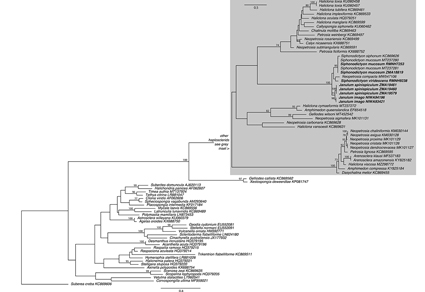Abstract
Historically, sponge classification is based on the interpretation of morphological characters, whose phylogenetic information content is frequently limited, subject to homoplasies, or prone to environmental plasticity (e.g., Chombard et al. 1998). Therefore, the currently accepted order-level classification of its largest class, Demospongiae, has been largely revised with molecular phylogenetic data (Morrow & Cárdenas 2015). Nevertheless, numerous sponge genera with ambiguous or provisoric phylogenetic placement still await definite classification.
References
Boury-Esnault, N., Pansini, M. & Uriz, M.J. (1994) Spongiaires bathyaux de la mer d’Alboran et du golfe ibéro-marocain. Memoirs du Museum National d’Histoire Naturelle, Zoologie, 160, 1–174.
Cárdenas, P., Pérez, T. & Boury-Esnault, N. (2012) Sponge systematics facing new challenges. In: Becerro, M.A., Uriz, M.J., Maldonado, M. & Turon, X. (Eds.), Advances in Marine Biology. Vol. 2. Academic Press, New York, New York, pp. 79–209. https://doi.org/10.1016/B978-0-12-387787-1.00010-6
Castresana, J. (2000) Selection of conserved blocks from multiple alignments for their use in phylogenetic analysis. Molecular Biology and Evolution, 17, 540–552. https://doi.org/10.1093/oxfordjournals.molbev.a026334
Chombard, C., Boury-Esnault, N. & Tillier, A. (1998) Reassessment of homology of morphological characters in tetractinellid sponges based on molecular data. Systematic Biology, 47, 351–366. https://doi.org/10.1080/106351598260761
De Laubenfels, M.W. (1936) A discussion of the sponge fauna of the Dry Tortugas in particular, and the West Indies in general, with material for a revision of the families and orders of the Porifera. Carnegie Institute of Washington Publication. Papers of the Tortugas Laboratory 30, 1–225.
Erpenbeck, D., Ekins, M., Enghuber, N., Hooper, J.N.A., Lehnert, H., Poliseno, A., Schuster, A., Setiawan, E., De Voogd, N.J., Wörheide, G. & Van Soest, R.W.M. (2016a) Nothing in (sponge) biology makes sense – except when based on holotypes. Journal of the Marine Biological Association of the United Kingdom 96, 305–311. https://doi.org/10.1017/S0025315415000521
Erpenbeck, D., Voigt, O., Al-Aidaroos, A.M., Berumen, M.L., Büttner, G., Catania, D., Guirguis, A.N., Paulay, G., Schätzle, S. & Wörheide, G. (2016b) Molecular biodiversity of Red Sea demosponges. Marine pollution bulletin, 105, 507–514. https://doi.org/10.1016/j.marpolbul.2015.12.004
Hooper, J.N.A. (2002) Family Raspailiidae Hentschel, 1923. In: Hooper, J.N.A. & Van Soest, R.W.M. (Eds.), Systema Porifera. Guide to the classification of sponges. Kluwer Academic/ Plenum Publishers, New York, Boston, Dordrecht, London and Moscow, pp. 469–510. https://doi.org/10.1007/978-1-4615-0747-5_53
Kelly, M., Erpenbeck, D., Morrow, C. & Van Soest, R. (2015) First record of a living species of the genus Janulum (Class Demospongiae) in the Southern Hemisphere. Zootaxa, 3980 (2), 255–266. https://doi.org/10.11646/zootaxa.3980.2.6
McCormack, G.P., Erpenbeck, D. & Van Soest, R.W.M. (2002) Major discrepancy between phylogenetic hypotheses based on molecular and morphological criteria within the Order Haplosclerida (Phylum Porifera: Class Demospongiae). Journal of Zoological Systematics and Evolutionary Research = Zeitschrift fur zoologische Systematik und Evolutionsforschung, 40, 237–240. https://doi.org/10.1046/j.1439-0469.2002.00204.x
Morrow, C. & Cárdenas, P. (2015) Proposal for a revised classification of the Demospongiae (Porifera). Frontiers in zoology, 12, 7. https://doi.org/10.1186/s12983-015-0099-8
Posadas, N., Baquiran, J.I.P., Nada, M.A.L., Kelly, M. & Conaco, C. (2022) Microbiome diversity and host immune functions influence survivorship of sponge holobionts under future ocean conditions. The ISME journal 16, 58–67. https://doi.org/10.1038/s41396-021-01050-5
Redmond, N.E., Morrow, C.C., Thacker, R.W., Díaz, M.C., Boury-Esnault, N., Cárdenas, P., Hajdu, E., Lobo-Hajdu, G., Picton, B.E., Pomponi, S.A., Kayal, E. & Collins, A.G. (2013) Phylogeny and systematics of Demospongiae in light of new small-subunit ribosomal DNA (18S) sequences. Integrative and comparative biology, 53, 388–415. https://doi.org/10.1093/icb/ict078
Redmond, N.E., Raleigh, J., van Soest, R.W.M., Kelly, M., Travers, S.A.A., Bradshaw, B., Vartia, S., Stephens, K.M. & McCormack, G.P. (2011) Phylogenetic relationships of the marine Haplosclerida (Phylum Porifera) employing ribosomal (28S rRNA) and mitochondrial (cox1, nad1) gene sequence data. PLoS ONE, 6, e24344. https://doi.org/10.1371/journal.pone.0024344
Schmidt, O. (1880). Die Spongien des Meerbusen von Mexico (Und des caraibischen Meeres). Heft II. Abtheilung II. Hexactinelliden. Abtheilung III. Tetractinelliden. Monactinelliden und Anhang. Nachträge zu Abtheilung I (Lithistiden). In: Reports on the dredging under the supervision of Alexander Agassiz, in the Gulf of Mexico, by the USCSS ‘Blake’. Gustav Fischer, Jena, pp. 33–90, pls. V–X.
Stamatakis, A. (2014) RAxML version 8: a tool for phylogenetic analysis and post-analysis of large phylogenies. Bioinformatics, 30, 1312–1313. https://doi.org/10.1093/bioinformatics/btu033
Vacelet, J. (1969) Éponges de la roche du large et de l’étage bathyal de Méditerranée. Mémoires du Muséum National d’Histoire Naturelle (A), 59, 145–219.
Wiedenmayer, F. (1994) Contributions to the Knowledge of Post-Palaeozoic Neritic and Archibenthal Sponges (Porifera): The Stratigraphic Record, Ecology, and Global Distribution of Intermediate and Higher Taxa. Schweizerische Paläontologischen Abhandlungen, 116, 1–147.


